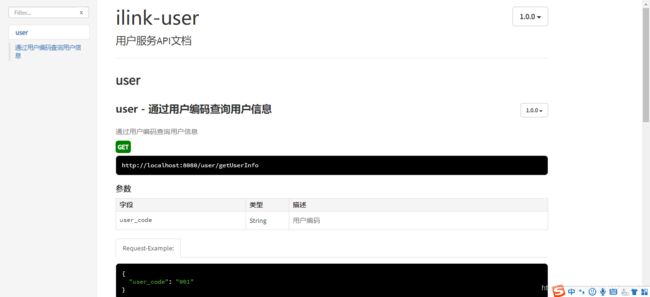express项目 apidoc 自动生成文档简洁教程
本文是关于apidoc的配置教程,具体的参数请参考官方网站
全局安装apidoc
npm i apidoc -g
配置api-doc
方式1:根目录添加apidoc.json(推荐),apidoc.json内容如下,具体属性请参考
{
"name": "user-service",
"version": "1.0.0",
"description": "用户服务API文档",
"title": "user-service API Doc",
"url": "http://localhost:8080/",
"sampleUrl": "http://localhost:8080/",
"forceLanguage": "zh-cn",
"template": {
"withCompare": true,
"withGenerator": true
}
}方式2:项目package.json配置api-doc
{
"name": "test",
"version": "0.0.0",
"private": true,
"scripts": {
"start": "node ./bin/www"
},
"dependencies": {
"cookie-parser": "~1.4.3",
"debug": "~2.6.9",
"ejs": "~2.5.7",
"express": "~4.16.0",
"http-errors": "~1.6.2",
"morgan": "~1.9.0"
},
"devDependencies": {
"express-session": "^1.15.6",
"mysql": "^2.15.0"
},
"apidoc": {
"name": "user-service",
"version": "1.0.0",
"description": "用户服务API文档",
"title": "user-service API Doc",
"url": "http://localhost:8080/",
"sampleUrl": "http://localhost:8080/",
"forceLanguage": "zh-cn",
"template": {
"withCompare": true,
"withGenerator": true
}
}
}
编写api文档
以我的项目为例,我的api请求明细写在routes中,那么,我将api文档写在routes的文件中
以查询用户数据的接口为例
var express = require('express');
var router = express.Router();
/**
* @apiDefine CODE_200
* @apiSuccess (Reponse 200) {Number} code 0 为成功,-1位异常
* @apiSuccess (Reponse 200) {Json/Array/Null} data 数组或null,需要根据情况判断,一般有值时为数据类型,没有值时为[]或null
* @apiSuccess (Reponse 200) {String} msg 请求成功/失败描述信息
* @apiSuccess (Reponse 200) {String} [error_code] 错误码,有时没有
* @apiSuccessExample {json} Response 200 Example
* HTTP/1.1 200 OK
* {
* "code": 0,
* "data": [],
* "msg": "操作成功"
* }
*/
/**
* 通过用户编码查询用户信息
* @api {get} user/getUserInfo 通过用户编码查询用户信息
* @apiName getUserInfo
* @apiDescription 通过用户编码查询用户信息
* @apiGroup user
* @apiVersion 1.0.0
* @apiParam {String} user_code 用户编码
* @apiParamExample {type} Request-Example:
* {
* "user_code": "001"
* }
* @apiSuccessExample {type} Success-Response
* HTTP/1.1 200 OK
* {
* "code": 0,
* "data": [
* {
* "user_img": "",
* "user_name": "",
* "user_code": "",
* "sex": "",
* "national": "",
* "idcard": "",
* "age": ""
* }
* ],
* "msg": "返回成功"
* }
* @apiSampleRequest http://localhost:8080/user/getUserInfo
* @apiUse CODE_200
*/
router.get('/user/getUserInfo', function (req, res, next) {
res.json({
code: 0,
data: [{
"user_img": "",
"user_name": "",
"user_code": "",
"sex": "",
"national": "",
"idcard": "",
"age": ""
}],
msg: "返回成功"
});
});
module.exports = router;
设置静态文件目录
一般这一步在创建项目的时候已经完成,但还是需要检查一下,假设我们需要将文档内容生成再public目录下,我们需要在app.js中配置
// 设置 public 文件夹为存放静态文件的目录
app.use(express.static(path.join(__dirname, 'public')));
生成文档
打开终端,cd到项目的根路径下,执行以下命令
apidoc -i routes/ -o public/apidoc/其中,-i 是api目录; -o 是生成文档的目的地。生成完成后,项目根路径下会生成public/apidoc文件夹。
预览
启动项目,在浏览器中输入 http://localhost:3000/apidoc
其中,3000 是项目启动的端口号,这里是不固定的,视情况而定。打开成功后,会出现这样的内容
至此,文档生成成功。

